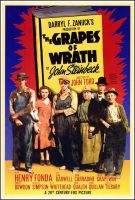The Grapes of Wrath movie storyline. The Joad clan, introduced to the world in John Steinbeck’s iconic novel, is looking for a better life in California. After their drought-ridden farm is seized by the bank, the family — led by just-paroled son Tom — loads up a truck and heads West. On the road, beset by hardships, the Joads meet dozens of other families making the same trek and holding onto the same dream. Once in California, however, the Joads soon realize that the promised land isn’t quite what they hoped.
The Grapes of Wrath (1940) is director John Ford’s most famous epic drama in black and white – the classic adaptation of John Steinbeck’s 1940 Pulitzer Prize winner, widely read 1939 novel. [The sentimental film is much more closely linked to social protest plays of Ford, the indicator (1935) and How Green Was My Valley (1941) as his masterly westerns.] This film was the most popular film Left Socialists on the subject before the World War II Hollywood.
The film’s title is taken from the Battle Hymn of the Republic by Julia Ward Howe (“My eyes have seen the glory of the coming of the Lord, He is trampling on vintage where the grapes of wrath are stored, it loosed the fateful lightning of His terrible swift sword, His truth is on “). On the screen, the film honestly and realistically recreates the socioeconomic impact of the Great Depression and drought of the mid-30s on a family representative – the Joad. The epic theme of moving to a new house oppressed parallels the biblical story of Exodus. Their name, Joad, also evokes the biblical character of Job.
Nunnally Johnson script is remarkably faithful to its source material Steinbeck. Not present in the novel or screenplay is a ledge it ends in the movie sentimentally optimistic and affirms the strength and dignity of the individual mind. Many other times, Hollywood has capitalized on other Steinbeck works and adapted for the screen: Of Mice and Men (1939), Tortilla Flat (1942), The moon is down (1943), Pearl (1948 ), the Red Pony (1949), East of Eden (1955), and Cannery Row (1982).
There were a total of seven Oscar nominations for the film – with two wins: Best Actress (Jane Darwell) in his role as the archetypal mother figure, and best director (John Ford). The five other nominations were best picture (which lost to Rebecca Hitchcock), Best Actor (Henry Fonda in one of his biggest film roles), Best Screenplay (Nunnally Johnson), Best Sound Recording, and Best Editing. In the same year, when ten were named best picture, director Ford had another entry: The Long Voyage Home (1940). A year earlier, Lewis Milestone directed another adaptation of a classic novel by John Steinbeck, the tragedy Of Mice and Men (1939), with Oscar nominations for five years and no one wins.
The plight of the Joad family is universalized as a microcosm of thousands of farmers from other countries during times of crisis, who have suffered oppression imposed by banks, large mechanized agricultural interests. The Dispossessed, leaving the migrant’s family from their land windy and dusty, and their slow disintegration provides an overview of thousands of Oklahoma, Colorado, Texas Panhandle, and W. Kansas families who were expelled and driven from their “farmland Dust Bowl,” and forced to search westward in the inhospitable Eden of California for jobs and survival of thousands of other migrant workers.
Jane Darwell is wonderful (although his accent is not appropriate) that the strong center and backbone of the family migrating to leave their ancestral lands and Henry Fonda is wonderful as a ruthlessly-harrassed Okie who refuses to be beaten and crushed by misfortune. film’s themes include the centrality of the family, suffering and oppression of the peasants, the emptiness of the American Dream, the display of human dignity and spirit in adversity, and questions social and economic justice. original cast for the film called to Beulah Bondi as Ma Joad, James Stewart, Al, and Walter Brennan as Pa Joad.
Filmed in journalism, documentary-style black and white textures with soft lighting and chiaroscuro (often provided by a source of candle or low light) – beautifully captured by the cinematography of Gregg Toland Experts (remarkably non-named) , The image files with skillful realism rural America of the 30s. visual images [A year earlier, Toland had been director of photography for Wuthering Heights (1939), and a year later, he completed the cinematography on Citizen Kane (1941), often considered the best film ever made.] Toland in this film resembles the migrant worker photographs taken by photographer Dorothea Lange during the Depression. And the musical score by Alfred Newman used variations of “Red River Valley” to give the film added flavor.
It is indeed ironic that Peter Fonda, son of the main star of the film, alongside the role of his father in The Grapes of Wrath in his own primary role in Easy Rider (1969), Wyatt – another independent, heroic wandering nomads in the U.S. Southwest in pursuit of frustrated dreams and a better life and more idyllic. However, in pursuing the American dream, like the quest for the Joad family, he traveled from California (the supposed land of opportunity) to New Orleans – in the opposite direction.
The Grapes of Wrath (1940)
Directed by: John Ford
Starring: Henry Fonda, Jane Darwell, John Carradine, Charley Grapewin, Dorris Bowdon, Russell Simpson, O.Z. Whitehead, John Qualen, Eddie Quillan, Zeffie Tilbury, Frank Sully, Frank Darien
Screenplay by: Nunnally Johnson
Cinematography by: Gregg Toland
Film Editing by: Robert L. Simpson
Costume Design by: Gwen Wakeling
Set Decoration by: Thomas Little
Art Direction by: Richard Day, Mark-Lee Kirk
Music by: Alfred Newman
Distributed by: 20th Century Fox
Release Date: January 24, 1940
Views: 204


